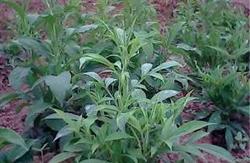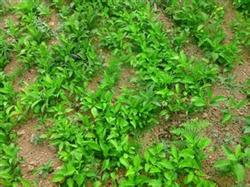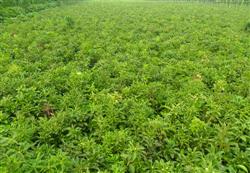Pollution-free cultivation techniques of Atractylodes macrocephala Koidz

Atractylodes macrocephala Koidz is the dry rhizome of Atractylodes macrocephala Koidz, also known as Atractylodes macrocephala Koidz, Atractylodes macrocephala Koidz and so on. It has the functions of tonifying spleen and invigorating stomach, drying warm and diuresis, stopping sweating and calming fetus and so on. 1. Morphological characteristics Atractylodes macrocephala Koidz is a perennial herb with a height of 30 ~ 80cm. The rhizome is thick and thick, slightly fist-shaped, grayish yellow, the stem is erect, the base is Lignification. Leaves alternate, the lower part of the stem has a long stalk, leaf blade 3-parted or pinnately 5-parted, margin with spiny teeth; upper stem petiole gradually shorter, leaf blade undivided, oval or ovate-lanceolate. Head solitary at the end of branches, large; involucral bracts 7-8 layers, surrounded by a pinnately parted leaflike involucre; flowers mostly borne on flat receptacle, all tubular flowers, Corolla purple; stamens 5, polyanthers, anthers linear; pistil 1, ovary inferior. Achenes oblong-elliptic, slightly flat, surface tomentose, crown feathery. The flowering period is from July to September and the fruiting period is from September to November. Second, the growth habit of Atractylodes macrocephala Koidz likes cool climate, afraid of high temperature and humidity, the suitable temperature for rhizome growth is 26 ℃ ~ 28 ℃, and the fastest expansion period is from mid-August to late September. Seeds are easy to germinate, and the optimum temperature for germination is about 20 ℃, and more water is needed, which is generally 3 ~ 4 times of seed weight. The life span of seeds is 1 year. Third, cultivation techniques 1. The sandy loam with general fertility, good drainage, high dryness and cool ventilation should be selected for land selection and seedling preparation, and farm manure 2000kg should be applied per mu as base fertilizer, 20cm should be deeply ploughed and raked flat and fine to form a border 1 ~ 1.2m wide. Field should choose fertile, ventilated, cool, well-drained sandy loam, avoid continuous planting. After the former crops were harvested, farm manure 4000kg was applied per mu, combined with 50kg superphosphate as base fertilizer, and 20cm was turned deeply into a border with a width of 1 ~ 1.5 m. two。 The method of reproduction is propagated by seeds, and the method of seedling and transplanting is mainly used in production. (1) raising seedlings. The new species with full grains and no diseases and insect pests were selected and soaked in warm water of 25 ℃ ~ 30 ℃ for 24 hours. Sowing in late March to early April, the sowing method is strip sowing or sowing. Before sowing, spray water on the border first, after the underwater topsoil is slightly dry, sow according to the row spacing 15cm, the ditch depth is 4 ~ 6cm, the sowing area is 7 ~ 9cm, the bottom of the ditch should be flat, cover the soil after sowing, slightly suppress, and then water once, using seed 4kg per mu or so. Sower, after underwater infiltration, sow the seeds evenly, then cover the shallow soil, about 5kg can be used per mu. About 15 days after sowing, seedlings emerged, and before transplanting in winter, 400kg could be cultivated per mu. (2) transplanting. It can be transplanted in winter of that year, but it is cold in winter in Zhangye City, so it needs to be planted in winter, Tibet and spring. The technique is planted without leaves and flowering in the same year, the main bud is strong, the rhizome is small and neat, and the apricot stone is large. Cut the fibrous root, cut the furrow of the deep 10cm according to the row spacing 25cm, arrange the technical planting into the ditch according to the plant spacing 15cm, the bud tip is upward, and level with the ground. After planting, there was a slight suppression on both sides, and after all the planting was finished, the water was watered again. Generally, 50 ~ 60kg is needed for fresh planting per mu. 3. Field management (1) Seedling (technical planting) management. Weeds were removed in time after the seedlings were unearthed and the seedlings were planted between 4 and 6cm according to the plant spacing. If the weather is dry, grass can be spread among the plants to reduce water evaporation. Where conditions permit, water can be watered in the morning and evening or sprinkler irrigation can be used to fight drought. If leaves are found in the later stage of growth, they should be removed in time. (2) field management. During the period from the seedling unearthed to May, there are many weeds in the field, the weeding in the field should be diligent, the first few ploughing can be deeper, and then the shallow hoe should be done. After the middle of May, the plant enters the peak growth period and generally no longer ploughs. If there are weeds among the plants, they can be pulled out by hand. The buds began to appear in the middle of June, and the buds were usually removed in batches after budding and before flowering in the early and middle of July. Picking buds is beneficial to improve the yield and quality of Atractylodes macrocephala rhizome. During the growth period of Atractylodes macrocephala Koidz, sufficient water is needed, especially in the period of rhizome expansion, and should be irrigated in time in case of drought. If the stagnant water after rain should be drained in time. Before and after budding, topdressing can be applied once, and urea 20kg and compound fertilizer 30kg are applied in the furrow between rows per mu, and then covered with soil and watered. One week after bud picking, topdressing can be done again. It should be noted that field operations such as weeding, loosening soil, fertilization and bud picking should be carried out after the dew is dry. 4. There are many diseases and insect pests in Atractylodes macrocephala Koidz, which often occur as follows: (1) blight. Low temperature and high humidity are easy to occur, most of which occur in the technical planting ground, causing damage to the rhizome. Control method: reduce the humidity in the field; at the initial stage of the disease, 50% carbendazim 1000-fold solution was used to irrigate. (2) Iron leaf disease. Also known as leaf blight. It started in April, especially from June to August, causing damage to leaves. Control methods: remove the diseased plants; use 1 ∶ 1 ∶ Bordeaux solution at the initial stage of the disease, and spray with 50% methyl or carbendazim 1000 times solution at the later stage. (3) White silk disease. Also known as root rot. The disease occurs in the same period as iron leaf disease, causing damage to the rhizome. Control methods: rotation with Gramineae crops; removal of diseased plants and disinfection of disease holes with raw lime powder; (4) root rot. Also known as root rot. The disease occurs in the same period as iron leaf disease, especially when the humidity is high, causing damage to the roots. Control methods: breeding disease-resistant varieties; rotation with Gramineae crops, or flood-drought rotation; soaking seeds with 1000-fold solution of 50% carbendazim for 5-10 minutes before planting; watering the disease area with 1000-fold solution of 50% carbendazim or 50% methyl topiramate at the initial stage of the disease. In the areas where underground pests are seriously damaged, dimethoate or trichlorfon can be irrigated with 1000 ~ 1500 times liquid. (5) rust. It started in May, causing damage to the leaves. Prevention and treatment methods: clean the countryside; spray with 1000 times solution at the initial stage of the disease. In addition, there are Sclerotinia sclerotiorum, mosaic disease, aphids, root-knot nematodes, southern dodder, small tigers and so on. The use of any pesticides is prohibited from 7 to 10 days before harvest, and the use of highly toxic pesticides is strictly prohibited throughout the growing season. Fourth, harvest from late October to mid-November, when the stems and leaves of Atractylodes macrocephala Koidz began to wither, dig out the roots and cut off the stems. Fifth, seed retention technology Atractylodes macrocephala Koidz can be divided into plant selection and slice selection, the former can improve seed purity. Generally from July to August, those with strong plants, small branches, large leaves and flattened buds are selected as the mother plants. It is better to remove late or early blooming buds and leave 5 ~ 6 buds per plant. Seeds were collected in the first and middle of November. Dig up the plant and cut off the underground rhizome on a sunny day, tie the aboveground part into small handfuls, hang it upside down under the eaves for 20 ~ 30 days, then cook it for 1 ~ 2 days, thresh, remove the hairs and shrunken seeds, put it in a cloth bag or gunny bag, and store it in a ventilated and cool place. Note that the seeds of Atractylodes macrocephala Koidz should not be exposed for a long time, otherwise the germination rate will be reduced.
- Prev

It is important to protect seedlings in order to achieve high yield of atractylodes macrocephala
As a kind of traditional Chinese medicine with high economic value, atractylodes macrocephala is planted by more and more people. However, due to the uneven level of planting and management, the economic benefits of growers vary greatly. Especially in the early stage, the growth habits and pest control of atractylodes macrocephala are not accurate, often causing a large number of dead seedlings in the early stage of atractylodes macrocephala, and...
- Next

Five points should be grasped in the cultivation of Atractylodes macrocephala Koidz
Atractylodes macrocephala Koidz, also known as Atractylodes macrocephala, Atractylodes macrocephala, and so on, is a plant of Compositae. The rhizome can be used in medicine and has the functions of strengthening spleen, dryness and dampness, calming the fetus and so on. It is a kind of valuable traditional Chinese medicine. Planting Atractylodes macrocephala Koidz in rural areas is a way to get rich with less investment, short production cycle, smooth marketing and high economic benefits. 1. Land selection and preparation. Atractylodes macrocephala likes a cool climate.
Related
- Fuxing push coffee new agricultural production and marketing class: lack of small-scale processing plants
- Jujube rice field leisure farm deep ploughing Yilan for five years to create a space for organic food and play
- Nongyu Farm-A trial of organic papaya for brave women with advanced technology
- Four points for attention in the prevention and control of diseases and insect pests of edible fungi
- How to add nutrient solution to Edible Fungi
- Is there any good way to control edible fungus mites?
- Open Inoculation Technology of Edible Fungi
- Is there any clever way to use fertilizer for edible fungus in winter?
- What agents are used to kill the pathogens of edible fungi in the mushroom shed?
- Rapid drying of Edible Fungi

